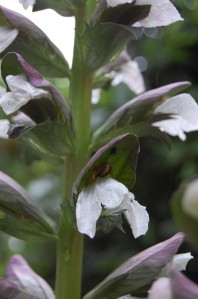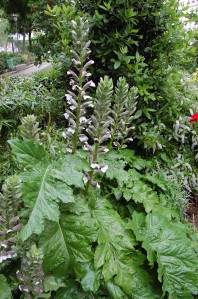Position: Full sun to partial shade.
Soil: Moist, well drained.
Flowering period: Late summer.
Eventual Height: 1.5m
Eventual Spread: 90cm
Hardiness: 7b, 8a, 8b, 9a
Family: Acanthaceae
Acanthus mollis is an semi-evergreen perennial with a clump forming habit. It has obovate, deeply lobed, dark green leaves. In summer it bears 1m long racemes composed of white flowers with purple shaded bracts, often on purple stems.
Acanthus mollis, commonly known as Bear’s Breeches, is native to south west Europe and north west Africa. It features in Greek mythology and was also used in stone carvings by both the Greeks and the Romans to decorate a wide range of architectural features, such as Corinthian and Composite order columns, dentils, and friezes. In Greek mythology Acantha was a nymph who resisted Apollo’s romantic advances and was turned into the plant as punishment.
The etymological root of the binomial name Acanthus is derived fro the ancient Greek akanthos meaning ‘a prickle’ in reference to some members of the genus being spiny. mollis is derived from the Latin translating as ‘soft’, ‘tender’ or ‘velvety’.
Acanthus mollis may be useful to the landscape architect as an effective ground cover plant which tolerates a shady location. It provides dramatic flowering spikes during the summer months and has large bold leaves.
Acanthus mollis will tolerate almost any soil conditions; it will be happy in acid, neutral or alkaline pH levels, in loam, sand or chalk in a sheltered or exposed location facing any aspect including shady locations.
Ecologically, Acanthus mollis will cater to pollinating insects such as bees.
Acanthus mollis requires little to no maintenance, flower stems may be cut back after flowering. If the clumps become too large they may be split in spring or autumn. Powdery mildew may occasionally be a problem, generally under dry climatic conditions.






Leave a comment